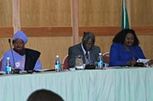UNDP and WHO with a strong message on alcohol, gender-based violence and HIV/AIDS
At a WHO/UNDP workshop in Namibia governments and NGOs were challenged to address alcohol-related harm, gender-based violence and HIV/AIDS in an integrated manner. Nine African countries are now following up at national level.
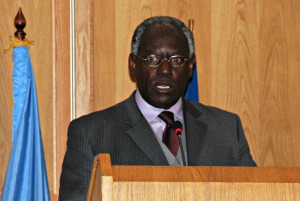 The WHO/UNDP workshop in Windhoek, Namibia gathered more than sixty representatives from nine countries, intergovernmental organisations and NGOs. In his opening speech, the UNDP Resident Coordinator, Mr. Musinga T Bandora (picture left), said that many countries have national policies in each of the three areas; alcohol-related harm, gender-based violence and HIV/AIDS. “They are, however, treated as separate problems. Now the time is due to address the nexus between the three. A multi-sectoral approach is needed, where alcohol use, GBV and HIV/AIDS are addressed in a concrete, integrated and systematic manner”, said Mr. Bandora and announced that the workshop in Namibia was a landmark event in this respect.
The WHO/UNDP workshop in Windhoek, Namibia gathered more than sixty representatives from nine countries, intergovernmental organisations and NGOs. In his opening speech, the UNDP Resident Coordinator, Mr. Musinga T Bandora (picture left), said that many countries have national policies in each of the three areas; alcohol-related harm, gender-based violence and HIV/AIDS. “They are, however, treated as separate problems. Now the time is due to address the nexus between the three. A multi-sectoral approach is needed, where alcohol use, GBV and HIV/AIDS are addressed in a concrete, integrated and systematic manner”, said Mr. Bandora and announced that the workshop in Namibia was a landmark event in this respect.
The UNDP representative said that a stricter control of production, sale and use of alcohol is critical for African countries, as the harmful use of alcohol is counterproductive to national development. He made reference to alcohol use as an important risk factor behind the HIV/AIDS epidemic and that alcohol use fuels violence, rapes and risky sexual behaviour. This was later documented in several presentations during the workshop.
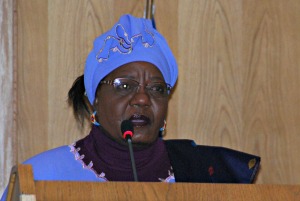
The guest of honour, Deputy Minister of Gender Equality and Child Welfare in Nambia, Honourable Mrs. Angelika Muharukua (picture right), also stressed that alcohol use is closely associated with gender-based violence and HIV/AIDS. She illustrated this by examples from everyday life in Namibia. Said the Deputy Minister: “We fought for our freedom to shape a new Namibia with economic development, education for all etc. Now we face the challenges from problems like gender-based violence and the HIV/AIDS epidemic”. She described alcohol use as a big, big problem for Namibia, in spite of the fact that it brings tax money to the government coffers.
“This initiative by WHO and UNDP is definitely a landmark event”, comments Project Coordinator Dag Endal from FORUT, which was one of the NGOs invited to serve as resource organisations at the workshop. “Combining policies and programs in the areas of alcohol, gender-based violence and HIV/AIDS will have many positive effects. It will give better results from existing efforts to combat both gender-based violence and the spread of HIV/AIDS. It will also create a stronger momentum for evidence-based alcohol policies in many countries. This will then contribute towards improved public health, safety for women and children, better family economy for the poor as well as overall national development”.
Eight Africa countries were invited by UNDP and WHO to participate in the workshop in Namibia and in an 18 months pilot programme. The aim of the program is to link and integrate national policies and programmes addressing gender-based violence, harmful use of alcohol and HIV prevention, treatment and care. More than sixty participants attended the workshop in Windhoek, which marked the start of the 18 months pilot period.
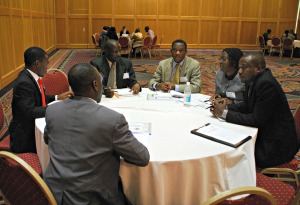 Each of these countries had delegations of 4-5 members; Botswana, The Democratic Republic of Congo, Guinea Bissau, Liberia, Sierra Leone, Zambia, Malawi, Zimbabwe and the host country Namibia. National delegations had members from ministries of health, gender equality etc., as well as from national HIV/AIDS agencies, police and relevant civil society organizations.( The Malawian delegation in the picture to the left)
Each of these countries had delegations of 4-5 members; Botswana, The Democratic Republic of Congo, Guinea Bissau, Liberia, Sierra Leone, Zambia, Malawi, Zimbabwe and the host country Namibia. National delegations had members from ministries of health, gender equality etc., as well as from national HIV/AIDS agencies, police and relevant civil society organizations.( The Malawian delegation in the picture to the left)
At the last day of the workshop the nine national delegations developed road maps for their national follow-up. These plans were rather ambitious and contained elements like: Reporting to own organisations, colleagues and superiors; stakeholders meeting; mapping of existing policies and programmes; establishing of a working group, steering committee, coordination committee; assessing existing policies and programmes etc.
The WHO/UNDP workshop was based on the best available knowledge on alcohol, gender issues and HIV/AIDS. Key facts from background papers and presentations were:
- Africa has an average alcohol consumption per capita 15 years and above of 6,0 litres. This is equal to the global average.
- The level proportion of non-drinkers is high in Africa, around 70 %.
- Those who drink in Africa, have a high consumption level and a risky drinking-pattern.
- 3.3 million deaths worldwide are attributable to alcohol consumption. This is equal to 5.9% of deaths in all age groups globally; 7.6% for men and 4.0% for women.
- Two-thirds of all people living with HIV are in Sub-Saharan Africa, which also has the highest prevalence of heavy episodic drinking in the world.
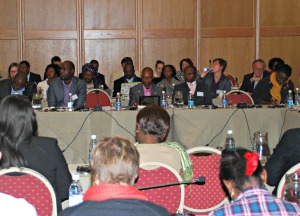 The potential interactions between alcohol-related risky behaviours – such as unprotected sex, low or interrupted medication adherence, lower utilisation of health care services – and biological factors such as increased susceptibility to infection (particularly among young women), makes alcohol consumption a facilitator for HIV transmission.
The potential interactions between alcohol-related risky behaviours – such as unprotected sex, low or interrupted medication adherence, lower utilisation of health care services – and biological factors such as increased susceptibility to infection (particularly among young women), makes alcohol consumption a facilitator for HIV transmission.- A recent WHO report confirmed that across the world, one out of three women will experience violence.
- The WHO report also noted that women experiencing intimate partner violence are almost twice as likely as other women to have alcohol-use problems and they are 1.5 times as likely to acquire HIV and they are almost twice as likely as other women to have alcohol-use problems.
RELATED ARTICLES
- New report highlights benefits of policy measures to prevent harmful alcohol consumption
- Alcohol use - a barrier to health and to the achievement of the SDGs
- Government investments in alcohol industry up against the wall
- Abstracts for GAPC 2020 – deadline 29 July 2019
- Involve young people as partners in prevention!
- A regional African alcohol coordination mechanism is needed
- New book reveals a series of unethical business practices by Heineken in Africa
- Next GAPC to be held in Dublin in March 2020
- SAFER – a new WHO initiative to boost national alcohol policy processes
- Trouble Brewing
